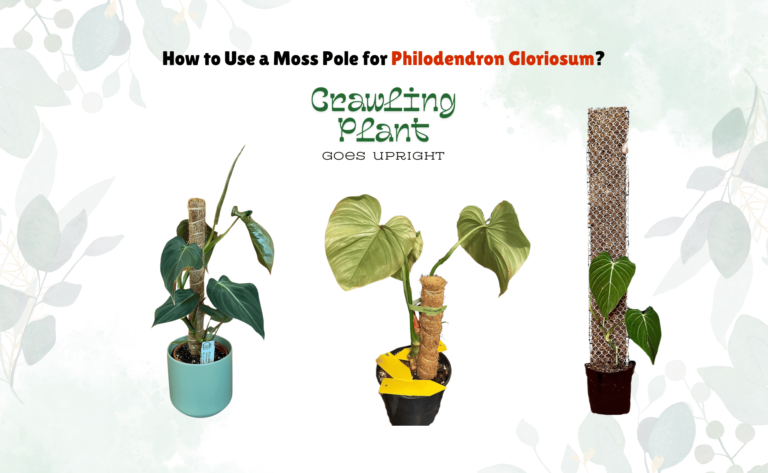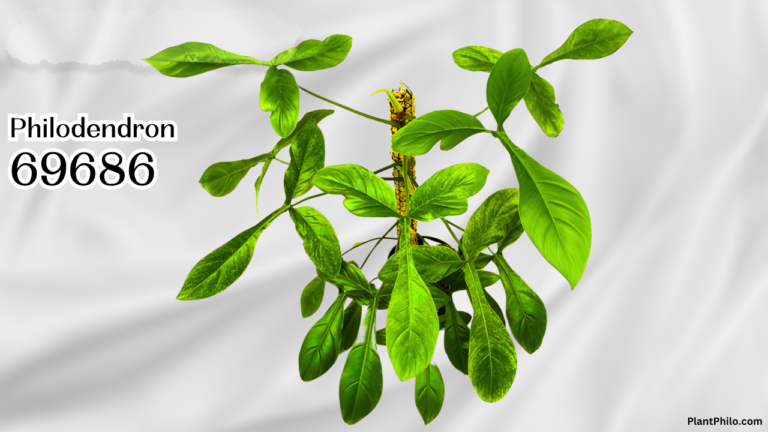Philodendron Pests and Diseases: Identification and Control Strategies
Have you ever watched your beloved Philodendron’s vibrant leaves suddenly turn yellow or spotty? The culprit might be lurking right under your nose, or even on your plant! Think your Philodendron is invincible? Don’t be fooled. Even the healthiest plants can fall prey to silent attackers. Arm yourself with the know-how to diagnose and treat the most common Philodendron pests and diseases, ensuring your plant thrives.
Philodendrons are cherished for their diverse foliage and adaptability, making them a popular choice among houseplant enthusiasts. Yet, the beauty and health of these tropical natives can be compromised by an array of pests and diseases.
From the sticky residue left by aphids to the fine webbing spun by spider mites, the warning signs of infestation can vary but are often unmistakable. Similarly, diseases such as root rot and leaf spot present distinct symptoms that require prompt attention.
Implementing treatment strategies promptly can restore your plant’s health, while preventative measures such as proper watering techniques and regular inspections help maintain a resilient philodendron.
Key Takeaways
- Regular surveillance for pests like aphids, mealybugs, and spider mites is essential in keeping philodendrons healthy.
- Philodendron diseases such as root rot and bacterial blight demand swift action to prevent the spread and plant decline.
- Proactive care, including adequate watering and the introduction of beneficial insects, is key to preventing pest infestations and diseases.
Troubleshooting Guide of Philodendron Leaves
Philodendrons are favored as houseplants due to their attractive foliage and adaptability to indoor conditions. However, like any plant, they are susceptible to certain pests and diseases.
Identifying and treating these problems promptly is crucial for maintaining a healthy philodendron.
| Problem | Possible Causes | Solution |
| Yellowing Leaves | Overwatering, underwatering, nutrient deficiency, low light, pests (aphids, mealybugs, spider mites), cold drafts, root rot | Adjust watering frequency, fertilize if needed, increase light exposure, treat pests with insecticidal soap or neem oil, move plant to warmer location, repot if rootbound |
| Browning Leaf Tips/Edges | Underwatering, low humidity, fluoride or salt buildup in water, too much fertilizer | Increase watering frequency, mist leaves regularly or use a humidifier, flush soil with distilled water, reduce fertilizer use or switch to a less concentrated formula |
| Wilting, Limp Leaves | Underwatering, overwatering (leading to root rot), heat stress | Water thoroughly if soil is dry, check for root rot (mushy roots, foul odor) and repot if necessary, move plant to a cooler location with indirect light |
| Spots or Discoloration on Leaves | Fungal or bacterial infection, pests (spider mites, scale) | Isolate the plant, remove affected leaves, increase air circulation, apply fungicide or bactericide if necessary, treat pests with insecticidal soap or neem oil |
| Stunted Growth | Low light, nutrient deficiency, rootbound, pests, cold temperatures | Increase light exposure, fertilize with a balanced fertilizer, repot into a slightly larger pot with fresh soil if roots are crowded, treat pests with insecticidal soap or neem oil, move plant to a warmer location with temperatures consistently above 55°F (13°C) |
| Leggy Growth with Sparse Foliage | Insufficient light | Move the plant to a brighter location with indirect light, prune back leggy stems to encourage bushier growth, consider using a grow light to supplement natural light |
| Leaves Drooping or Falling Off | Overwatering, underwatering, root rot, cold drafts, sudden temperature changes, pests | Adjust watering frequency, check for root rot and repot if necessary, move the plant to a warmer, draft-free location, avoid sudden temperature fluctuations, treat pests with insecticidal soap or neem oil |
| Distorted or Curled Leaves | Pests (aphids, thrips), low humidity, chemical burn from fertilizer or pesticides | Treat pests with insecticidal soap or neem oil, increase humidity by misting or using a pebble tray, flush the soil with distilled water if you suspect chemical burn, avoid spraying leaves with fertilizer or pesticides, dilute fertilizers before applying |
Identifying Common Philodendron Pests
Before diving into the specifics of each pest, it’s crucial to understand that philodendrons, while hardy, are susceptible to a range of sap-sucking insects and other pests that can seriously affect their health.
Being able to identify these common pests promptly can help you manage them effectively, utilizing treatments like insecticidal soap, neem oil, and horticultural oils.
1. Aphids
What they look like:
Aphids are tiny, pear-shaped insects that are typically green, black, red, yellow, brown, or gray. These soft-bodied pests measure a mere 1/16 to 1/8 inch long. They often have a wooly or waxy appearance, and adults typically do not have wings. Winged aphids tend to be slightly darker in color than their wingless counterparts.
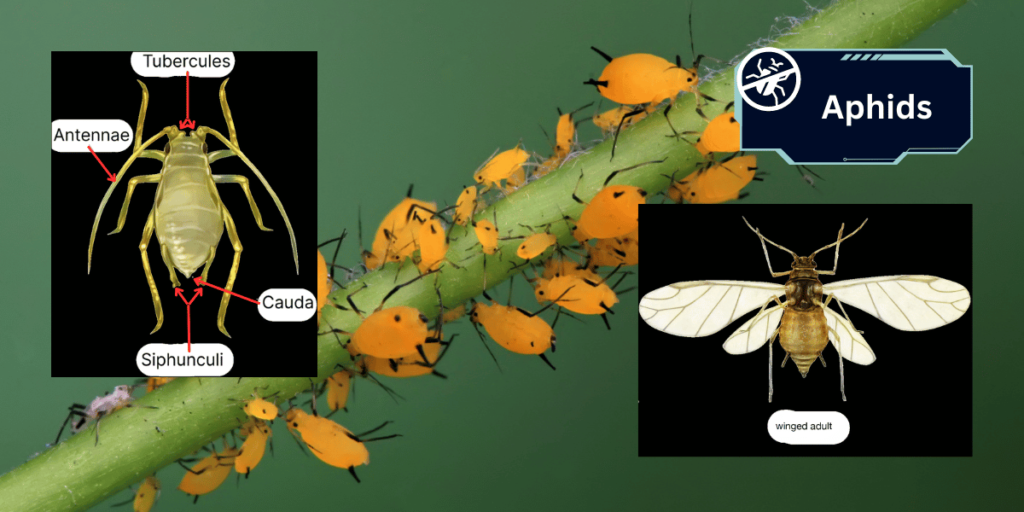
Plant damage
These tiny pests can cause significant damage by sucking sap from the leaves and stems of your Philodendron. Look for signs like yellowing or curling leaves and a sticky residue known as honeydew. Aphids can be managed by applying insecticidal soap or neem oil.
2. Caterpillars & Worms
What they look like:
Caterpillars, the larval phase of butterflies and moths, have segmented bodies with legs and often colorful patterns. They feed on leaves. Worms, on the other hand, have soft, legless bodies and move by contracting and expanding.
They typically reside in soil or leaf litter, though some are aquatic. The main difference is that caterpillars have legs and a defined head, while worms do not.
Plant damage:
Caterpillars and worms chew on the leaves, leaving visible holes or notches. Their presence is often evident by the irregular shapes eaten out of the leaves. Manually removing these pests or treating them with neem oil can be effective.
3. Flea Beetles
What they look like:
Flea beetles are tiny, jumping insects with hard, often metallic-colored bodies. They vary from 1/16 to 1/4 inch long and have large hind legs for jumping. These pests are known for feeding on leaves, creating small, round holes.
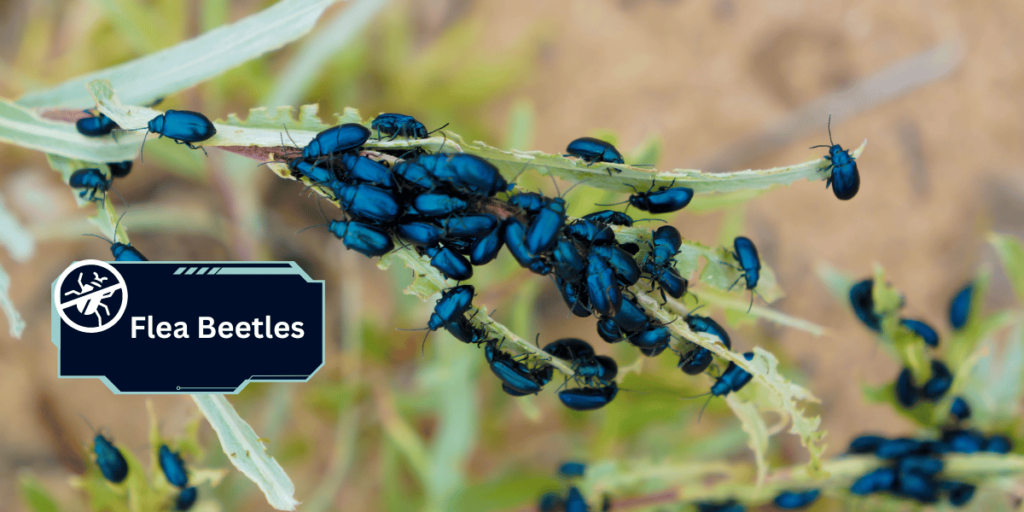
Plant damage:
Flea beetles leaves small holes in the leaves. They can be challenging to catch due to their jumping ability. Insecticidal soaps and horticultural oils are commonly used to combat them.
4. Fungus Gnats
What they look like:
Fungus gnats are tiny, dark-colored flies with long legs and antennas, nearly 1/8 inch long. They resemble tiny mosquitoes and have a delicate appearance. Their wings are clear and often have a Y-shaped vein pattern. You’ll often see them hovering around your plants or near the soil surface.
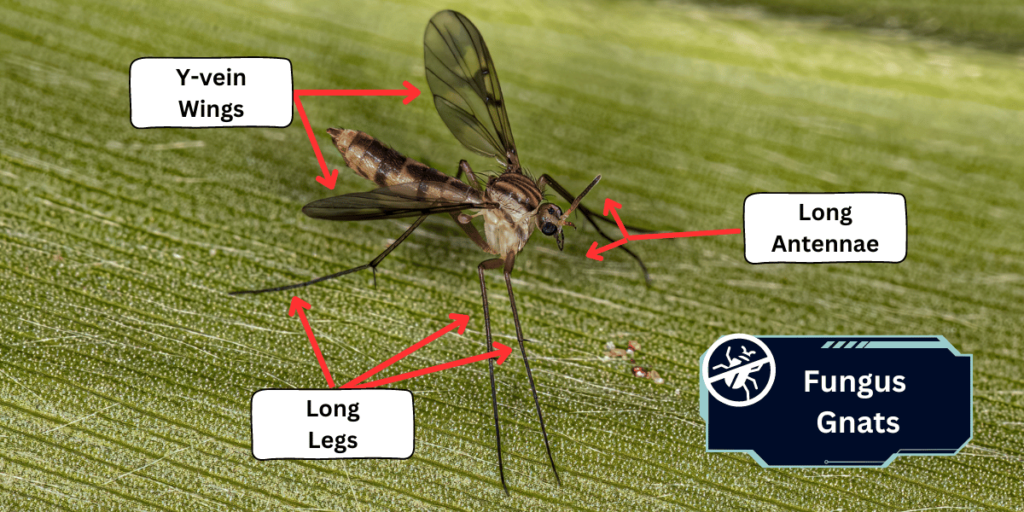
Plant damage:
Often confused with fruit flies, fungus gnats are tiny flying pests that thrive in moist soil. They cause root rot as larvae damage plant roots. If you see small, dark flies around your plant or larva in the soil, let the soil dry out between waterings, use yellow sticky traps, or apply beneficial nematodes.
5. Japanese Beetles
What they look like:
Japanese beetles are shiny, metallic green beetles with coppery-brown wing covers. They are about 1/2 inch long and have a distinctive oval shape. A key identifying feature is the five small patches of white hairs on each side of their abdomen and two additional white tufts at the tip.
Plant damage:
Japanese beetles feast on the foliage. Look for skeletonized leaves as a sign of infestation. Hand-picking and use of neem oil can aid in control.
6. Mealybugs
What they look like:
Mealybugs are small, usually 1/10 to 1/4 inch long, soft-bodied insects that often appear as white, cottony masses on leaves and stems. They are typically found on leaves, stems, and in plant crevices. Their waxy coating makes them look fluffy or fuzzy.
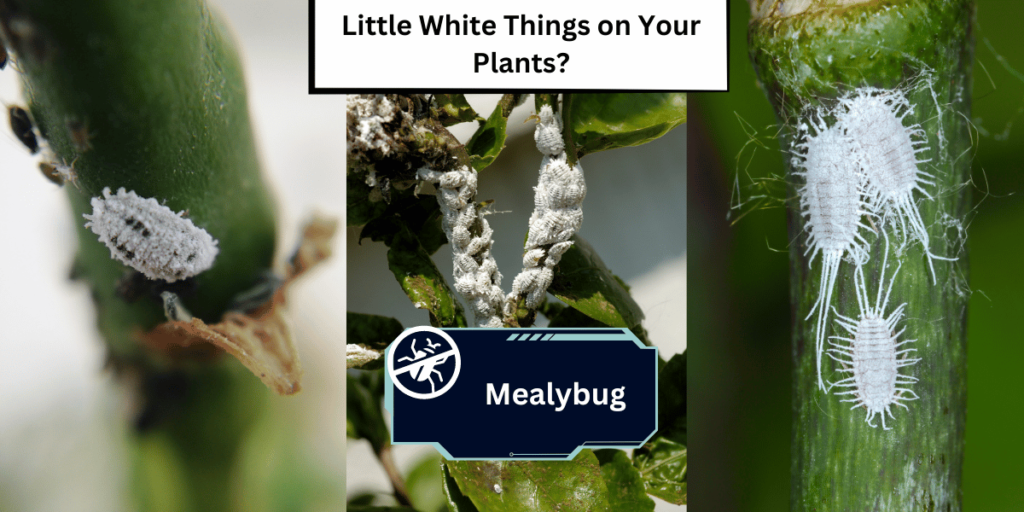
Plant damage:
Signs include white, fluffy accumulations and yellowing leaves. Treat these pests with isopropyl alcohol, which is applied with a cotton swab or insecticidal soap.
7. Scale Insects
What they look like:
Scale insects are tiny, sap-sucking pests that appear as immobile bumps or shells on plant surfaces. They come in various colors (brown, tan, gray, black) and sizes (1/16 to 1/4 inch) and are often found on stems, leaves, and fruits.
There are two main types: armored scales (hard shell) and soft scales (waxy covering). Early detection and treatment are crucial for plant health.
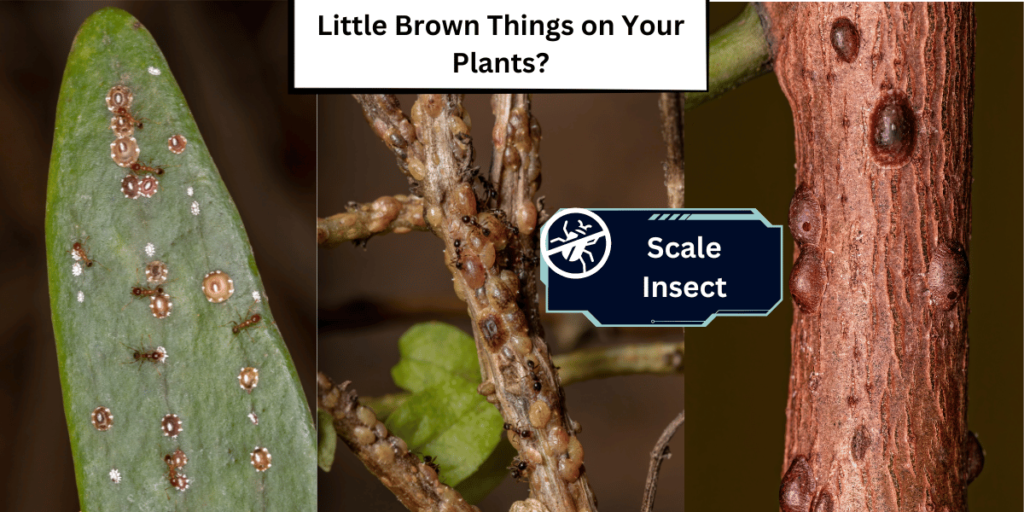
Plant damage:
Scale insects resemble small bumps on your Philodendron’s leaves and stems. Some produce honeydew, a sticky substance attracting ants and fostering sooty mold. Look for yellowing leaves, leaf drops, and stunted growth as signs of damage.
If you spot brown or black scales and a sticky honeydew residue, use a cotton swab dipped in rubbing alcohol for manual removal or apply horticultural oil.
8. Spider Mites
What they look like:
Spider mites are tiny arachnids, barely visible to the naked eye, that infest the undersides of leaves. These pests thrive in warm, dry conditions and reproduce rapidly, making them a common and persistent problem for indoor and outdoor plants.
Plant damage:
Tiny spider mites create fine webbing on the undersides of leaves and can cause leaves to appear stippled. They have piercing mouthparts that suck plant juices, causing stippling (tiny dots) on leaves, which may turn yellow or bronze and eventually fall off.
Infested plants may also exhibit fine webbing, especially in advanced stages. Increasing humidity and using insecticidal soap or neem oil can help manage an infestation.
Understanding Philodendron Diseases
Recognizing the signs and providing proper care is crucial to managing diseases in Philodendrons, a beloved group of houseplants. Addressing these issues promptly can prevent the spread of infection and safeguard the plant’s health.
1. Bacterial Leaf Spot
Bacterial leaf spot manifests as dark, wet-looking spots, often with a yellow halo, on the leaves. This disease is caused by bacteria, such as Xanthomonas campestris pv. dieffenbachiae, and thrives in humid conditions.
Affected leaves should be removed, and to avoid further spread, refrain from overhead watering.
2. Brown Leaf Tips
Brown leaf tips in Philodendrons typically signal that the air is too dry or that there’s a buildup of minerals from hard water. Ensure proper humidity and use filtered water if tap water is too harsh.
3. Leggy Growth or Small Leaves
When Philodendrons receive insufficient light, they may develop leggy growth or smaller leaves. Providing adequate, but not direct, sunlight encourages healthy foliage.
4. Loss of Variegation
If your variegated Philodendron is losing its variegation, this could be a sign of too little light. For these plants to maintain their beautiful colors, sufficient indirect light is crucial.
5. Root Rot
Root rot, typically caused by overwatering and poor drainage, leads to yellow leaves and a rotting base. This fungal disease requires immediate action: remove the plant from its pot, trim away the black, mushy roots, and repot into fresh soil with proper drainage.
6. Yellowing Leaves
Yellowing leaves can be a sign of overwatering, poor drainage, or nutrient deficiency. Ensure that your watering schedule allows the soil to dry out between sessions and that your pot has sufficient drainage holes. If the issue persists, consider a soil test to determine if nutrient supplementation is necessary.
Prevention Tips
Preventing pests and diseases in your Philodendrons is paramount to ensuring their health and vitality. By following these targeted measures, you can safeguard your plants from common afflictions, making your indoor gardening experience more rewarding and less frustrating.
1. Quarantine New Plants
Quarantine new additions to your plant collection for at least two weeks. This practice helps in preventing the spread of any undetected pests or diseases to your existing plants.
2. Inspect Regularly
Regularly inspect your Philodendrons for signs of pest or disease. These signs include yellowing leaves or unexplained wilting. Early detection allows for more effective management and treatment.
3. Proper Watering
Proper watering is crucial. Overwatering can lead to root rot, a common disease in Philodendrons. Ensure that you’re allowing the soil to dry out between waterings.
4. Good Air Circulation
Maintain good air circulation around your plant to help stave off fungal diseases. Room fans or open windows can aid in this effort, but avoid placing plants in drafty areas.
5. Cleanliness
Keep your plant area clean and regularly disinfect gardening tools. Cleanliness helps mitigate the risk of spreading diseases from one plant to another.
6. Introduce Beneficial Insects
Introducing beneficial insects like ladybugs or lacewings can be a natural way to manage pest populations. They actively feed on common plant pests.
Treatment Strategies
When caring for Philodendrons, it’s essential to have an effective treatment plan against pests and diseases. Below are targeted treatments designed to address specific problems, ensuring your plants remain healthy and robust.
1. Insecticidal Soap
Insecticidal soaps are effective against aphids, mealybugs, spider mites, and other soft-bodied pests. They work by breaking down the insect’s outer layer, leading to dehydration.
Apply insecticidal soap directly to the pests, being sure to cover all infested areas. Reapplication every 4-7 days may be necessary for full control.
2. Neem Oil
Neem oil, derived from the neem tree, acts as a natural pesticidal and fungicidal treatment. It disrupts the life cycle of pests upon contact and can also prevent fungal issues like leaf spot diseases.
Apply neem oil as a foliar spray, carefully following the dilution guide for effective prevention and treatment.
3. Horticultural Oil
Horticultural oils are highly refined oils designed to smother pests such as scale insects and mealybugs. They are best applied in cooler weather to avoid leaf burn.
When using these oils, ensure that you thoroughly cover all parts of the plant. The oil must make contact with the pests to be effective.
4. Chemical Pesticides or Fungicides
In the case of severe infestations or infections, chemical pesticides or fungicides may be the solution. They offer a more potent option to cure and manage issues like root rot, bacterial blight, and persistent insect problems.
Always adhere to the product’s label instructions for safe application and to prevent harm to the plant and environment.
Beneficial Insects for Philodendron
Philodendrons, beloved for their lush foliage and adaptability as houseplants, can thrive with proper care. Ensuring a balance of humidity, temperature, and maintenance, including regular pruning, is essential.
However, even with attentive care, pests can sometimes impede the growth and health of your Philodendron. Beneficial insects are natural allies that maintain the well-being of your plants by targeting and controlling common pests.
1. Ladybugs
Ladybugs are excellent to have around your Philodendron plants. These charming beetles are known to consume vast numbers of aphids, which are pests notorious for causing stunted growth and other damage to plants. They are especially beneficial in managing severe aphid infestations.
2. Lacewings
Lacewings, particularly their larvae, are voracious predators that can protect your Philodendrons. They feed on a variety of problematic insects, including aphids, mealybugs, and spider mites. Introducing lacewings into your houseplant care regimen can help curb these pest populations effectively.
3. Predatory Mites
These mites are allies in your fight against pests like spider mites. Predatory mites reside on the leaves and stems of your Philodendron, keeping watch for harmful pests. They are especially useful in maintaining a healthy environment without resorting to chemical treatments.
4. Beneficial Nematodes
Beneficial Nematodes represent a microscopic solution to soil-borne pests. These tiny worms target the larvae of pests such as fungus gnats, one of the common offenders in houseplant soil. Incorporating nematodes into your plant’s soil is a proactive measure to preserve your Philodendron’s health from the ground up.
Frequently Asked Questions
Philodendrons are cherished for their lush foliage and adaptability as houseplants, but like any living plant, they can encounter issues with pests and diseases. Understanding these challenges and knowing how to respond is crucial for keeping your philodendrons healthy and vibrant.
What are the common pests found on philodendron plants?
Philodendron plants might be infested by pests such as aphids, mealybugs, spider mites, and scale insects. These pests can cause various symptoms, including leaf yellowing, curling, and sticky residues.
How can you treat bacterial leaf spots on philodendrons?
Treating bacterial leaf spots involves removing affected leaves and improving air circulation around your Philodendron.
Various sources might recommend fungicide or bactericide applications, but make sure to follow manufacturer instructions for the safest and most effective use.
Which diseases are most likely to affect philodendron plants?
Philodendron plants can be affected by root rot, leaf spot diseases, and bacterial blight. These diseases usually result from overwatering, poor air circulation, or contaminated tools.
What are some effective treatments for philodendron pests?
Effective treatments for philodendron pests include insecticidal soaps, neem oil, and horticultural oil. Pests like mealybugs can also be removed manually with a cotton swab dipped in isopropyl alcohol.
How do you identify and manage leaf spot diseases in philodendrons?
To identify leaf spot diseases in philodendrons, look for brown, black, or yellow spots on the foliage. Manage these by removing affected leaves and avoiding overhead watering to prevent the spread of the disease and keep the foliage dry.
What could be causing my philodendron leaves to yellow and die?
Yellowing and dying leaves on a philodendron could be due to a range of issues. These include overwatering and poor soil drainage, which can lead to root rot, pest infestations, or a nutrient deficiency.
To identify potential causes, assess your watering habits and the plant’s location.


